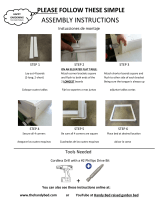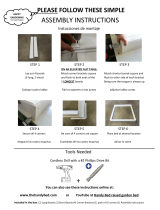
TRIM APPLICATION FOR WINDOWS, DOORS & OTHER OPENINGS
BAND BOARD
Trim the opening prior to the installation of the siding (Figure 8.7). Place a Flat Tab at the end of each trim board and one
tab every 16 in. OC. Attach the trim boards and Flat Tabs around the opening as shown in Figures 8.7 and 8.8.
A flashing is required over the trim and Flat Tabs. (Figure 8.9) Terminate ends of the Band Board into Trim or Siding or
miter cut the edges of the trim at the corners of the building. Place a Flat Tab at the end of each trim board and one tab
every stud at a maximum of 16 in. o.c. The Flat Tabs should be attached to the trim in an alternating pattern to the top
and bottom of the band board (Figures 8.10 and 8.11).
Application
Framing Material
Tab is nailed into
Flat Tab
Wood Stud
(minimum G=0.42)
Minimum APA rated
7/16" OSB
Corner Tab
Minimum APA rated
7/16" OSB
Minimum 20
gauge steel
Minimum 20
gauge steel
Wood Stud
(minimum G=0.42)
Fastener
(tab to Hardietrim)
Max Tab Spacing
(inches on center)
Four 18 ga. X 1/2"
long X 1/4" wide
corrosion resistant
crown staples,
equally spaced in
one row
16
For each piece of
trim, install Four 18
ga. X 1/2" long X
1/4" wide corrosion
resistant crown
staples, equally
space in two rows
20
Fastener
(tab to framing)
One 6d corrosion resistant siding nail
installed through center of flange into framing
Two 4d ring shank corrosion resistant
siding nails equally spaced installed
through flange into framing
One No. 8 X 1" long X 0.323" head
diameter screw (corrosion resistant)
installed through flange into framing
On each flange, Install one 6d
corrosion resistant siding nail through
flange into framing
On each flange, Install two 4d ring
shank corrosion resistant siding nails
through flange into framing
On each flange, Install one No. 8 X 1"
long X 0.323" head diameter screw
(corrosion resistant) through flange
into framing
Application
Framing Material
Tab is nailed into
Flat Tab
Wood Stud
(minimum G=0.42)
Minimum APA rated
7/16" OSB
Corner Tab
Minimum APA rated
7/16" OSB
Minimum 20
gauge steel
Minimum 20
gauge steel
Wood Stud
(minimum G=0.42)
Fastener
(tab to Hardietrim)
Max Tab Spacing
(inches on center)
Four 18 ga. X 1/2"
long X 1/4" wide
corrosion resistant
crown staples,
equally spaced in
one row
16
For each piece of
trim, install Four 18
ga. X 1/2" long X
1/4" wide corrosion
resistant crown
staples, equally
space in two rows
20
Fastener
(tab to framing)
One 6d corrosion resistant siding nail
installed through center of flange into framing
Two 4d ring shank corrosion resistant
siding nails equally spaced installed
through flange into framing
One No. 8 X 1" long X 0.323" head
diameter screw (corrosion resistant)
installed through flange into framing
On each flange, Install one 6d
corrosion resistant siding nail through
flange into framing
On each flange, Install two 4d ring
shank corrosion resistant siding nails
through flange into framing
On each flange, Install one No. 8 X 1"
long X 0.323" head diameter screw
(corrosion resistant) through flange
into framing
Application
Framing Material
Tab is nailed into
Flat Tab
Wood Stud
(minimum G=0.42)
Minimum APA rated
7/16" OSB
Corner Tab
Minimum APA rated
7/16" OSB
Minimum 20
gauge steel
Minimum 20
gauge steel
Wood Stud
(minimum G=0.42)
Fastener
(tab to Hardietrim)
Max Tab Spacing
(inches on center)
Four 18 ga. X 1/2"
long X 1/4" wide
corrosion resistant
crown staples,
equally spaced in
one row
16
For each piece of
trim, install Four 18
ga. X 1/2" long X
1/4" wide corrosion
resistant crown
staples, equally
space in two rows
20
Fastener
(tab to framing)
One 6d corrosion resistant siding nail
installed through center of flange into framing
Two 4d ring shank corrosion resistant
siding nails equally spaced installed
through flange into framing
One No. 8 X 1" long X 0.323" head
diameter screw (corrosion resistant)
installed through flange into framing
On each flange, Install one 6d
corrosion resistant siding nail through
flange into framing
On each flange, Install two 4d ring
shank corrosion resistant siding nails
through flange into framing
On each flange, Install one No. 8 X 1"
long X 0.323" head diameter screw
(corrosion resistant) through flange
into framing
Application
Framing Material
Tab is nailed into
Flat Tab
Wood Stud
(minimum G=0.42)
Minimum APA rated
7/16" OSB
Corner Tab
Minimum APA rated
7/16" OSB
Minimum 20
gauge steel
Minimum 20
gauge steel
Wood Stud
(minimum G=0.42)
Fastener
(tab to Hardietrim)
Max Tab Spacing
(inches on center)
Four 18 ga. X 1/2"
long X 1/4" wide
corrosion resistant
crown staples,
equally spaced in
one row
16
For each piece of
trim, install Four 18
ga. X 1/2" long X
1/4" wide corrosion
resistant crown
staples, equally
space in two rows
20
Fastener
(tab to framing)
One 6d corrosion resistant siding nail
installed through center of flange into framing
Two 4d ring shank corrosion resistant
siding nails equally spaced installed
through flange into framing
One No. 8 X 1" long X 0.323" head
diameter screw (corrosion resistant)
installed through flange into framing
On each flange, Install one 6d
corrosion resistant siding nail through
flange into framing
On each flange, Install two 4d ring
shank corrosion resistant siding nails
through flange into framing
On each flange, Install one No. 8 X 1"
long X 0.323" head diameter screw
(corrosion resistant) through flange
into framing
Application
Framing Material
Tab is nailed into
Flat Tab
Wood Stud
(minimum G=0.42)
Minimum APA rated
7/16" OSB
Corner Tab
Minimum APA rated
7/16" OSB
Minimum 20
gauge steel
Minimum 20
gauge steel
Wood Stud
(minimum G=0.42)
Fastener
(tab to Hardietrim)
Max Tab Spacing
(inches on center)
Four 18 ga. X 1/2"
long X 1/4" wide
corrosion resistant
crown staples,
equally spaced in
one row
16
For each piece of
trim, install Four 18
ga. X 1/2" long X
1/4" wide corrosion
resistant crown
staples, equally
space in two rows
20
Fastener
(tab to framing)
One 6d corrosion resistant siding nail
installed through center of flange into framing
Two 4d ring shank corrosion resistant
siding nails equally spaced installed
through flange into framing
One No. 8 X 1" long X 0.323" head
diameter screw (corrosion resistant)
installed through flange into framing
On each flange, Install one 6d
corrosion resistant siding nail through
flange into framing
On each flange, Install two 4d ring
shank corrosion resistant siding nails
through flange into framing
On each flange, Install one No. 8 X 1"
long X 0.323" head diameter screw
(corrosion resistant) through flange
into framing
Application
Framing Material
Tab is nailed into
Flat Tab
Wood Stud
(minimum G=0.42)
Minimum APA rated
7/16" OSB
Corner Tab
Minimum APA rated
7/16" OSB
Minimum 20
gauge steel
Minimum 20
gauge steel
Wood Stud
(minimum G=0.42)
Fastener
(tab to Hardietrim)
Max Tab Spacing
(inches on center)
Four 18 ga. X 1/2"
long X 1/4" wide
corrosion resistant
crown staples,
equally spaced in
one row
16
For each piece of
trim, install Four 18
ga. X 1/2" long X
1/4" wide corrosion
resistant crown
staples, equally
space in two rows
20
Fastener
(tab to framing)
One 6d corrosion resistant siding nail
installed through center of flange into framing
Two 4d ring shank corrosion resistant
siding nails equally spaced installed
through flange into framing
One No. 8 X 1" long X 0.323" head
diameter screw (corrosion resistant)
installed through flange into framing
On each flange, Install one 6d
corrosion resistant siding nail through
flange into framing
On each flange, Install two 4d ring
shank corrosion resistant siding nails
through flange into framing
On each flange, Install one No. 8 X 1"
long X 0.323" head diameter screw
(corrosion resistant) through flange
into framing
Application
Framing Material
Tab is nailed into
Flat Tab
Wood Stud
(minimum G=0.42)
Minimum APA rated
7/16" OSB
Corner Tab
Minimum APA rated
7/16" OSB
Minimum 20
gauge steel
Minimum 20
gauge steel
Wood Stud
(minimum G=0.42)
Fastener
(tab to Hardietrim)
Max Tab Spacing
(inches on center)
Four 18 ga. X 1/2"
long X 1/4" wide
corrosion resistant
crown staples,
equally spaced in
one row
16
For each piece of
trim, install Four 18
ga. X 1/2" long X
1/4" wide corrosion
resistant crown
staples, equally
space in two rows
20
Fastener
(tab to framing)
One 6d corrosion resistant siding nail
installed through center of flange into framing
Two 4d ring shank corrosion resistant
siding nails equally spaced installed
through flange into framing
One No. 8 X 1" long X 0.323" head
diameter screw (corrosion resistant)
installed through flange into framing
On each flange, Install one 6d
corrosion resistant siding nail through
flange into framing
On each flange, Install two 4d ring
shank corrosion resistant siding nails
through flange into framing
On each flange, Install one No. 8 X 1"
long X 0.323" head diameter screw
(corrosion resistant) through flange
into framing
8.7-A 8.7-B
8.8
8.9
8.10
8.11
8.12
Side trim pieces go to
the top of the window.
Header piece spans the window
including the side trim pieces.
Flashing needs to be
tucked under the water
resistive barrier and
over the Flat Tabs.
Do not caulk between the
siding and the flashing.
Water-resistive barrier
Water-resistive Barrier
Flat Tabs
Flat Tabs
FLUSH
Siding nail attaches
tab to the wall.
Do not under
drive nails.
Only use staples to fasten
Flat and Corner Tabs to the
trim boards.
16 in. o.c.
max
16 in. o.c.
max
Fasten 4 staples to the tab as shown
HardiePlank
®
Lap Siding
1/4 in. gap. Do not caulk.
Flashing
Caulk
Flat Tabs
Blocking
Sheathing
1/8 in. caulked gap is left between siding and
the side trim pieces.
1/4 in. gap
Bottom trim piece is the
width of the window.
NOTE: Follow your window/door manufacturers installation instructions.
Flat and
Corner Tabs
General
Product
Information
Working
Safely
Tools for
Cutting and
Fastening
General
Installation
Requirements
General
Fastener
Requirements
Finishing and
Maintenance
HardieTrim
®
Boards/Battens
HardieWrap®
Weather Barrier
HardieSoffit
®
Panels
HardiePlank
®
Lap Siding
HardieShingle
®
Siding
HardiePanel
®
Vertical Siding
Appendix/
Glossary
ESR-1844 &
2290 Report























